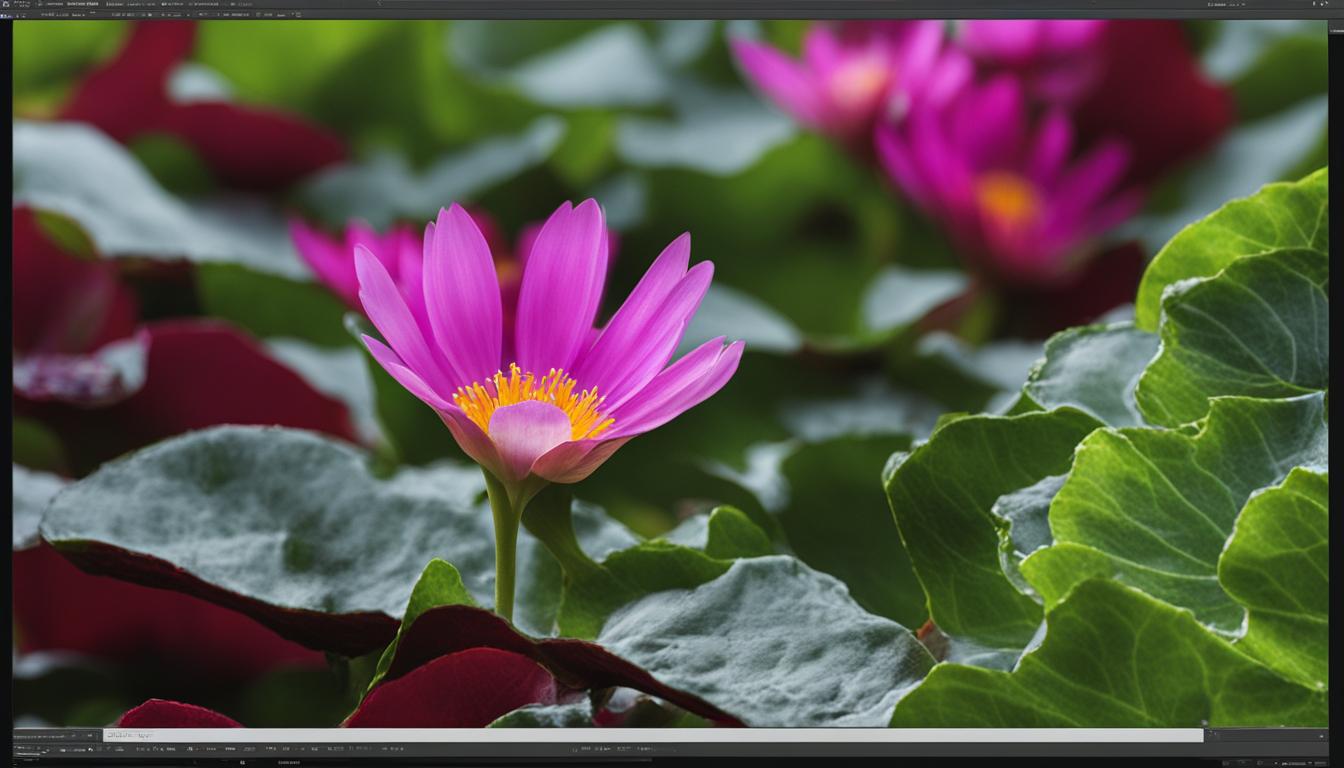Welcome to the world of post-processing, where your photographs can be transformed into stunning visuals with just a few clicks. Editing software has revolutionized the way we approach photography, allowing us to take our images to new creative heights. Post-processing is the art of refining and enhancing photographs using editing software. With advanced features and tools, photographers can transform raw images into masterpieces that truly captivate their audience.
Editing software is more than just a tool to correct minor errors or enhance colors; it’s a gateway to unlocking the full creative potential of your photographs. Post-processing allows you to experiment with different artistic styles, pushing the boundaries of your creativity and taking your images to new heights.
Key Takeaways:
- Post-processing is the art of refining and enhancing photographs using editing software.
- Editing software allows photographers to transform raw images into stunning visuals.
- Post-processing unlocks the full creative potential of your photographs.
- Advanced features and tools in editing software enable experimentation with different artistic styles.
- Post-processing takes your images to new heights and captivates your audience.
Understanding Post-Processing: A Visual Enhancement Journey
If you’re new to post-processing, it can seem overwhelming at first. But understanding the techniques involved in editing software can take your photography to the next level by enhancing the visual appeal of your images.
The power of post-processing lies in its ability to transform photographs. Whether you’re correcting exposure, cropping, or adjusting color and contrast, the end result can be a stunning image that tells a story. Post-processing enables you to manipulate the pixels of an image to achieve a desired effect, whether that’s a subtle tweak or a dramatic change.
At the heart of post-processing is the goal of enhancing the visual impact of your photos. Whether that’s by improving the lighting, emphasizing details, or adjusting the colors, post-processing provides a way to achieve your vision for the image.
“Post-processing is like a magical journey that transforms a photograph into a story.”
Understanding post-processing also means understanding the software and tools used to achieve the desired results. This includes using software such as Adobe Lightroom or Photoshop, as well as familiarizing yourself with key tools, such as the histogram, levels, and masking.
One of the key benefits of post-processing is the ability to experiment and push the boundaries of your creativity. With a wide range of techniques available, you can explore different styles and create unique compositions.
To showcase the transformative power of post-processing, take a look at the before and after images below:
Before Post-Processing
| Exposure: | Underexposed |
| Color: | Flat and dull |
| Contrast: | Low contrast |
After Post-Processing
| Exposure: | Corrected exposure |
| Color: | Vibrant colors |
| Contrast: | Increased contrast |
As you can see, post-processing can make a significant difference in the visual impact of a photograph. Understanding post-processing and its tools can ultimately help you achieve your creative vision and enhance the narrative of your photos.
Expanding Your Creative Horizons with Editing Software
Editing software is a powerful tool that can help photographers expand their creative horizons. With advanced features and tools, editing software enables photographers to experiment with different styles and push the boundaries of their creativity.
One of the advantages of editing software is the ability to undo mistakes and try out different ideas without having to worry about damaging the original photograph. This freedom allows photographers to take risks and try out new techniques they might not otherwise have attempted.
Editing software also allows photographers to experiment with different color schemes, contrasts, and light settings, giving them control over the overall mood and atmosphere of their photographs. With the ability to manipulate every aspect of the image, photographers can create unique and visually stunning compositions.
Benefits of Using Editing Software
There are several benefits to using editing software in photography:
- Expands creative possibilities
- Allows for experimentation and risk-taking
- Provides control over the final outcome of photographs
- Enables the creation of unique and visually stunning compositions
Examples of Expanding Creative Horizons with Editing Software
Editing software can be used to create a wide range of creative and unique photographs. Here are some examples:
| Before | After |
|---|---|
| Original photo of a forest | Edited photo with enhanced saturation and contrast, giving it a surreal and dream-like quality |
| Original photo of a cityscape | Edited photo with vibrant colors and a dramatic sky, giving it a futuristic and otherworldly feel |
These examples showcase how editing software can enhance the visual appeal of photographs and provide photographers with the ability to explore different artistic styles.
Unleashing the Power of Filters and Presets in Photo Editing
Filters and presets are powerful tools that can transform your photographs in an instant. These editing features offer a wide range of artistic effects, from vintage and retro styles to modern and edgy looks. The possibilities are endless, and with the right application, filters and presets can take your photography to the next level.
Filters are pre-designed settings in editing software that can change the color, contrast, and overall mood of your image. They can add warmth, coolness, or drama, and many other effects. Presets, on the other hand, are collections of filters that can be applied in combination to produce unique visual styles.
To use filters and presets in your editing process, you need to have a clear understanding of what you want to achieve. You should select the right filter or preset that best suits the subject, the lighting, and the mood you want to convey.
For example, if you want to create a vintage-style photograph, you can choose a filter that adds a warm, faded tone to your image. Alternatively, if you want to give your image a modern, edgy vibe, you can select a filter that increases the contrast and saturation.
Using filters and presets can save time in your editing process and provide consistent results. They allow you to experiment with different styles and effects quickly, without having to make manual adjustments every time. However, it is important to use them judiciously, as excessive application can take away from the natural look and feel of your image.
Mastering the Art of Retouching: Enhancing Details and Correcting Flaws
Retouching is a crucial aspect of post-processing that enables photographers to enhance details and correct flaws in their photographs, creating flawless images that capture the essence of their vision. To master the art of retouching, photographers need to understand the techniques and tools used to achieve the desired results.
Enhancing Details
Enhancing details is essential to create sharp and crisp images, highlighting the beauty and depth of the subject matter. In editing software, photographers can use various tools to enhance details, such as the Clarity, Sharpening, and Noise Reduction tools.
The Clarity tool can add depth and richness to images by enhancing the contrast in the mid-tones. The Sharpening tool can enhance the details in the image by increasing the edge contrast and creating a sharper appearance. The Noise Reduction tool can reduce the appearance of digital noise in the image, which can detract from the overall quality of the photograph.
Correcting Flaws
Correcting flaws is a critical aspect of retouching, enabling photographers to remove blemishes, spots, and other imperfections that detract from the visual appeal of their images. In editing software, photographers can use various tools to correct flaws, such as the Spot Healing, Clone Stamp, and Patch tools.
The Spot Healing tool can automatically remove small blemishes by analyzing the surrounding pixels and replacing them with an appropriate texture. The Clone Stamp tool can remove larger blemishes by copying a selected area and pasting it over the blemish. The Patch tool can correct larger flaws by selecting an area and replacing it with the texture from another part of the image.
Mastering the art of retouching is essential for photographers who want to create visually stunning images that capture the essence of their vision. By enhancing details and correcting flaws, photographers can create flawless images that showcase their talent and creativity, and stand out from the rest.
The Magic of Adjustments: Fine-Tuning Your Photos for Maximum Impact
Adjustments are one of the most powerful tools in photo editing software. With the ability to fine-tune exposure, color balance, and composition, photographers can elevate their images to the next level.
At the heart of adjustments is the magic of fine-tuning. By using these tools, photographers can adjust the exposure to bring out the details in highlights and shadows, creating a more balanced and visually pleasing image. They can also enhance the color balance, making the colors more vibrant and accurate. Finally, they can refine the composition of the photo, ensuring that all the elements come together to create a harmonious and impactful visual.
Fine-tuning Exposure: Highlighting Details and Balancing Tones
Adjusting exposure is all about balancing the highlights and shadows in a photo. With the right adjustments, photographers can bring out the details in the highlights and shadows, creating a more dynamic and visually interesting image.
When fine-tuning exposure, photographers can adjust the brightness, contrast, and shadows of the photo. By adjusting the brightness, they can make the photo brighter or darker. By adjusting the contrast, they can make the photo more or less vibrant. Finally, by adjusting the shadows, they can bring out details that would otherwise be lost in the shadows.
Enhancing Color: Balancing Hues and Saturation for Stunning Visuals
Color is one of the most important elements in photography. With adjustments, photographers can enhance the color of their photos, making them more vibrant and accurate.
When fine-tuning color, photographers can adjust the hue, saturation, and color balance of the photo. By adjusting the hue, they can change the overall color of the photo. By adjusting the saturation, they can make the colors more or less vibrant. Finally, by adjusting the color balance, they can balance the colors in the photo, making them more accurate and pleasing to the eye.
Refining Composition: Creating a Harmonious and Impactful Visual
Composition is the arrangement of elements in a photo. By refining the composition, photographers can create a more impactful and visually pleasing image.
When fine-tuning composition, photographers can adjust the crop, alignment, and perspective of the photo. By adjusting the crop, they can crop the photo to create a more interesting composition. By adjusting the alignment, they can straighten out the lines in the photo, making it more visually appealing. Finally, by adjusting the perspective, they can change the angle of the photo, creating a more dynamic and engaging visual.
In conclusion, the magic of adjustments is all about fine-tuning photos for maximum impact. By adjusting exposure, enhancing color, and refining composition, photographers can create stunning visuals that capture the eye and engage the viewer.
Exploring Advanced Techniques: Layering, Masking, and Blending
In photo editing, advanced techniques like layering, masking, and blending can be used to create complex and visually stunning compositions. These techniques give photographers the ability to combine multiple images, adjust specific areas of a photograph, and create unique visual effects.
Layering involves stacking multiple images on top of each other, allowing the photographer to selectively edit and manipulate each layer individually. This technique is particularly useful for compositing, where different elements of an image are combined to create a new and visually engaging composition. By layering images, photographers can create depth, add texture, and combine multiple visual elements in one cohesive image.
Masking is another advanced technique that allows photographers to selectively adjust specific areas of an image. By creating a mask, photographers can isolate certain parts of an image and apply adjustments or effects to only those areas. This technique is particularly useful for adjusting exposure, enhancing details, and correcting flaws in an image.
Blending involves combining two or more images together, creating a seamless transition between them. This technique is often used to create surreal or dreamlike images, where multiple photographs are blended together to create a unique and visually stunning image. By experimenting with blending modes and opacity levels, photographers can create a wide range of different effects and moods.
| Layering | Masking | Blending |
|---|---|---|
By mastering these advanced techniques, photographers can take their images to new artistic heights, and create unique and visually stunning compositions that stand out from the rest.
Streamlining Your Workflow: Efficient Editing Tips and Tricks
Editing can be a time-consuming process, but by streamlining your workflow, you can save time and increase efficiency. Here are some tips and tricks to help you edit your photos more efficiently:
- Organize your files: Before you start editing, make sure your photos are organized and easy to find. Use a consistent file naming convention and create folders to keep your photos organized by project, date, or subject.
- Batch edit: If you have a series of photos that require similar edits, such as exposure or color adjustments, use batch editing to apply these changes quickly and efficiently.
- Use keyboard shortcuts: Familiarize yourself with the keyboard shortcuts in your editing software to speed up your workflow. This can save you time and reduce the strain on your hands and wrists.
- Create presets: If you frequently use the same editing settings, create presets to apply these settings with just a few clicks.
- Eliminate distractions: Turn off notifications and other distractions while editing to help you stay focused and productive.
- Take breaks: Editing for long periods can be tiring and lead to mistakes. Take breaks to rest your eyes and clear your mind. This can help you stay focused and productive.
By incorporating these tips and tricks into your workflow, you can streamline your editing process and achieve more efficient and consistent results.
Conclusion
In conclusion, post-processing using editing software offers an incredible opportunity for photographers to elevate their visuals and unlock new creative possibilities. From understanding the basics of post-processing to exploring advanced techniques, the transformative power of editing software cannot be overstated.
By mastering the art of photo editing, photographers can enhance the visual appeal of their photographs, experiment with new artistic styles, and correct imperfections to create flawless images.
Furthermore, by streamlining the post-processing workflow, photographers can save time and achieve consistent results.
In essence, incorporating editing software into the photographic workflow is a game-changer. It allows photographers to take full control over the final outcome of their photographs, unleashing their creativity and pushing the boundaries of what is possible.
FAQ
What is post-processing?
Post-processing refers to the editing and enhancement of photographs using editing software. It allows photographers to transform their images, adjusting factors such as exposure, color, composition, and more, to achieve the desired visual impact.
Why is post-processing important?
Post-processing is important because it allows photographers to unleash the full potential of their photographs. It can enhance the overall aesthetics, correct flaws, and fine-tune various elements to create visually stunning images. It is a powerful tool for expressing creativity and conveying the desired message through photography.
What editing software can be used for post-processing?
There are several editing software options available for post-processing, including Adobe Photoshop, Lightroom, Capture One, and GIMP (GNU Image Manipulation Program), among others. These software offer a wide range of tools and features to edit and enhance photographs according to individual preferences and requirements.
Do I need to be an expert in editing software to post-process my photos?
No, you do not need to be an expert to post-process your photos. While learning and mastering editing software can enhance your editing skills, there are plenty of tutorials, online resources, and presets available that can help you achieve desired results even if you are a beginner. With practice and experimentation, you can improve your post-processing abilities over time.
Can post-processing be considered cheating in photography?
Post-processing is a common practice in photography and is not considered cheating. It is an integral part of the creative process, allowing photographers to enhance their images and bring out their artistic vision. However, it is important to maintain ethical standards and not manipulate images to misrepresent reality in certain contexts, such as photojournalism.
How much post-processing is too much?
The amount of post-processing applied to a photograph is subjective and depends on the desired outcome and personal style. Some photographers prefer a more natural look with minimal editing, while others may choose to push the boundaries of creativity with extensive edits. It is essential to find a balance that aligns with your artistic vision and the message you want to convey through your photographs.
Can I post-process images taken with my smartphone?
Yes, you can post-process images taken with your smartphone. Most smartphones now come with built-in editing features, and there are also numerous editing apps available for both iOS and Android devices. These apps provide a range of tools and options to enhance your smartphone photos and unleash their full potential.






